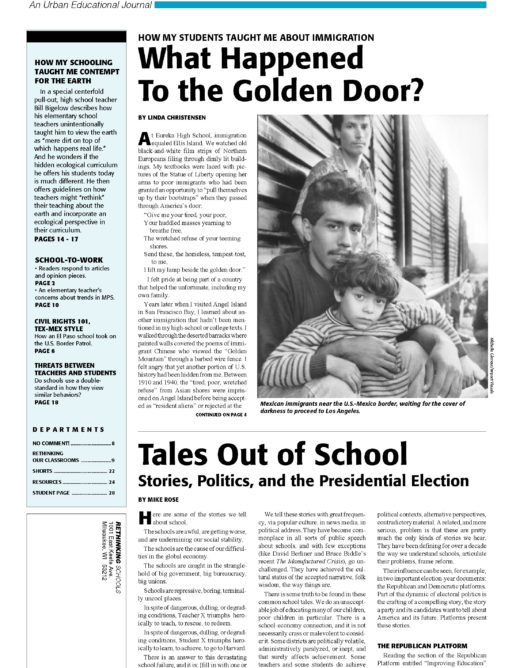Preview of Article:
What Happened To the Golden Door?
I started fourth quarter by outlining my goals and expectations. I do this each term, so students know what kinds of pieces must be in their portfolio: for example, a literary essay comparing two novels, an essay exploring a historical issue, a poem that includes details from history, etc. As part of the opening of the quarter ceremonies, I passed out an outline of their upcoming project.(Show me the outline.) I wanted a lengthy deadline so students would have the opportunity to work the entire quarter on the project.
Before students started their research, I modeled how I wanted the lessons taught by presenting Chinese and Japanese immigration. While students who come through the Jefferson network of elementary, middle, and high schools get at least surface background knowledge of Native Americans and African Americans, they appear to know less about Asian or Latino literature or history. In fact, students are often surprised that the Japanese and Chinese faced any prejudice.
During the lessons on Japanese Americans, students examined Executive Order 9066 signed by President Roosevelt, which gave the military the right to force Japanese Americans from their homes and businesses into camps surrounded by barbed wire and guard towers. Because these “resident aliens” and U.S. citizens were allowed to take only what they could carry to the “camps,” they were forced to sell most of their possessions in a short period of time. Students read “Echoes of Pearl Harbor,” a chapter from Nisei Daughter by Monica Sone, where she describes her family burning their Japanese poetry, kimonos, breaking their Japanese records, destroying anything that could make them look like they cherished their Japanese heritage. Students wrote moving poetry and interior monologues imagining they were forced to leave their homes, businesses, and treasured possessions. “Becoming American,” was written by Khalilah Joseph:
“I looked into the eyes of my
Japanese doll
and knew I could not surrender her
to the fury of the fire.
My mother threw out the poetry
she loved;
my brother gave the fire his sword.
We worked hours
to vanish any traces of the Asian world
from our home.
Who could ask us
to destroy
gifts from a world that molded
and shaped us?
If I ate hamburgers
and apple pies,
if I wore jeans,
then would I be American?”
Recently, I came across Beyond Words: Images from America’s Concentration Camps, a fascinating book of personal testimony and artwork produced in the camps: black-and-white drawings, watercolors, oil paintings and pieces of interviews that gave me a window into the lives of the imprisoned Japanese. While I showed slides of the artwork, students I prompted ahead of time read “Legends from Camp” by Lawson Inada, “The Question of Loyalty,” by Mitsuye Yamada, and segments of the internees’ interviews that matched pictures on screen. With images and words of the prisoners in their minds, students wrote their own poems. Thu Throung’s poem is called “Japanese Prisoners”:

